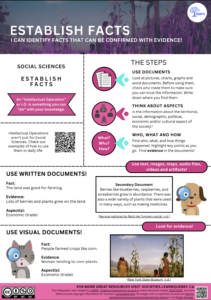
Exploring history, geography, and citizenship is a bit like being a detective. It often starts by observing social phenomena in your environment. You can try to figure out why things are the way they are now.
You might want to investigate:
- Who lives on a specific territoryA territory is an area of land, or sometimes of sea, that we can say “belongs”…? How did they come to live there? What did life on this territoryA territory is an area of land, or sometimes of sea, that we can say “belongs”… look like during specific periods in time?
- What is the territoryA territory is an area of land, or sometimes of sea, that we can say “belongs”… used for now? How has it been used in the past? Who used it?
- What are places in my area named after? Who came up with these names?
- What are the roles of different people in my territoryA territory is an area of land, or sometimes of sea, that we can say “belongs”… today? How have these roles changed over time? How are the roles people have similar and different across societies?
- What is an object used for? Who invented it? When was it invented?
We have worked hard to gather information to help you become your very best history detective. Let’s learn more about the intellectual operations, documents, and aspects of society to help you along your way!
—————————-
The Intellectual Operations:
Once you know what you will investigate, you must establish facts using documents. This is why Establish Facts is one of the main Intellectual Operations (or IOs for short!). IOs are things you can “do” with your knowledge and documents. In Elementary, there are 8 IO’s. Can you practice them all and earn your IO badges?
There is a link to infographics to help you learn more about each IO.

Using Sources:
Like a real detective, you need to establish facts from many different sources and back up your facts with evidence. You can use videos, books, images, artifacts, and more. Getting all your information about a society or a territoryA territory is an area of land, or sometimes of sea, that we can say “belongs”… from one document is kind of like only interviewing one person about a crime; you may miss a lot of important information and different perspectives! To get to the truth, you need more than one source!
Here is a link to an infographic that shows different kinds of sources.

Similar to real detective work, it is always best to use primary sources. Primary sources are things that were created during the time period you are studying. It is also good to use sources produced by the society you are learning about or sources made by many different societies or social groups.
Finally, just like a real detective, you should record your sources in case you or someone else needs to recheck them. You should also ensure their reliability. Here is a short MediaSmarts video with tips on fact-checking sources!
The Aspects:
 There are many different aspects of societies. When learning about societies and territories during specific periods, it can be helpful to group information by aspect to more easily interpret changes over time or similarities and differences between societies. This document has descriptions of aspects of society. You may also want to use these Competency Synthesis Placemats to help record what you learn about different aspects as you progress through the Social Science program.
There are many different aspects of societies. When learning about societies and territories during specific periods, it can be helpful to group information by aspect to more easily interpret changes over time or similarities and differences between societies. This document has descriptions of aspects of society. You may also want to use these Competency Synthesis Placemats to help record what you learn about different aspects as you progress through the Social Science program.
Check your knowledge:
The Competencies:
Even though you will get one mark for Social Sciences on your report card, your teacher is evaluating three competencies. Knowing about these competencies helps you better understand what you are being marked on.
Competency 1 has to do with understanding how one society is organized on a territoryA territory is an area of land, or sometimes of sea, that we can say “belongs”….
Competency 2 has to do with how one society changes over time.
Competency 3 has to do with how two societies that existed at the same time (but not necessarily in the same place) are similar and different.
Check your knowledge:
